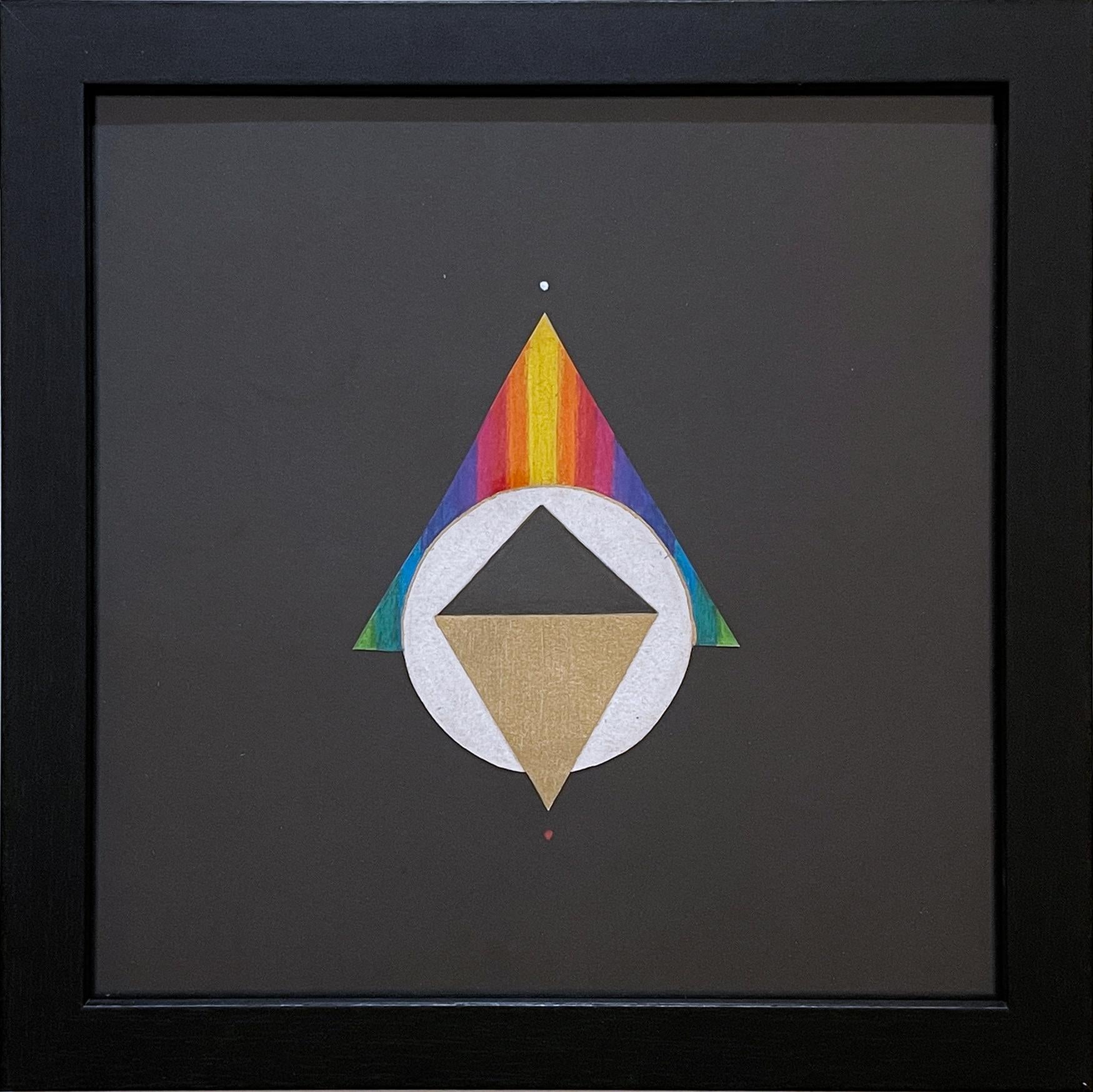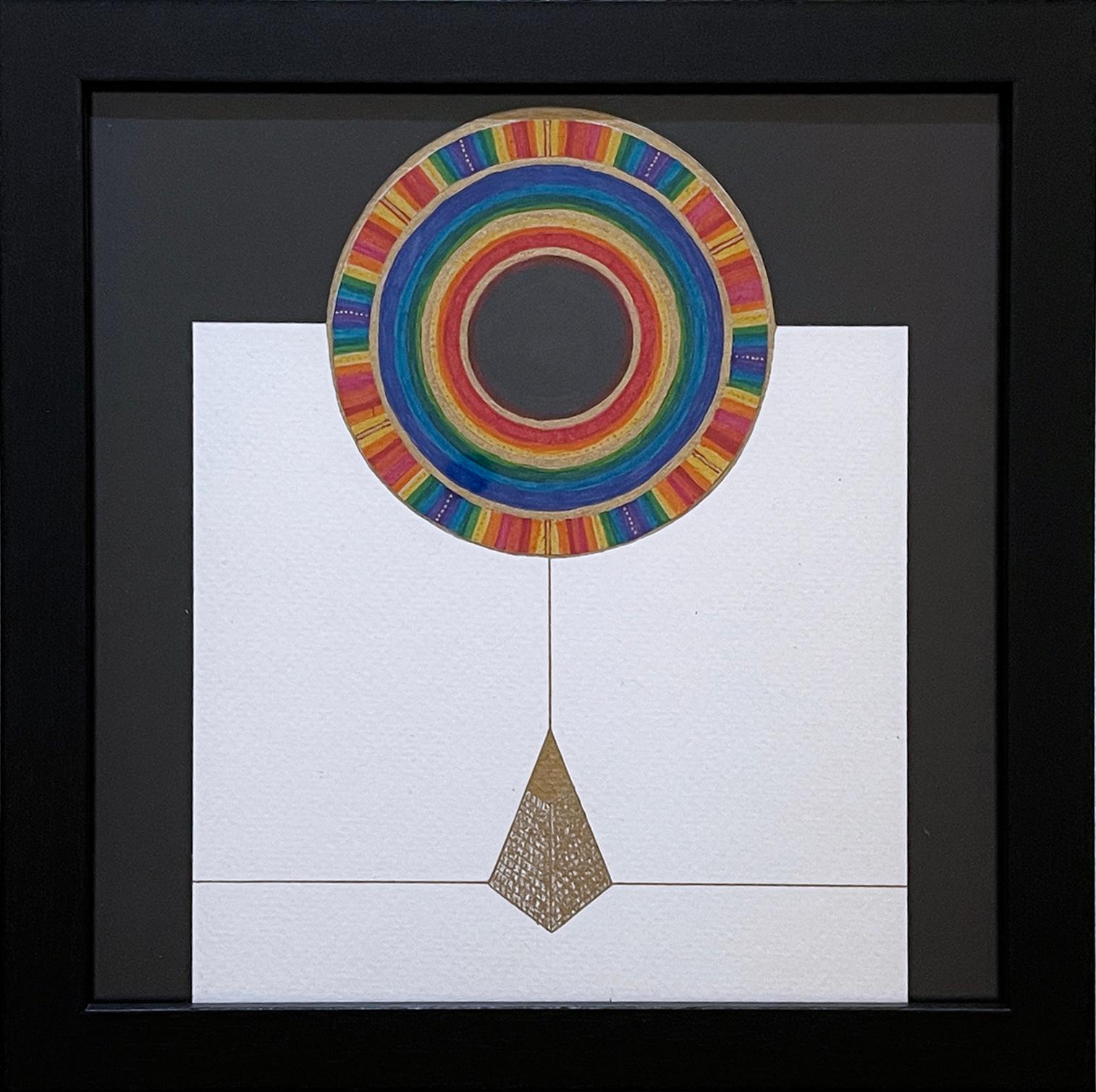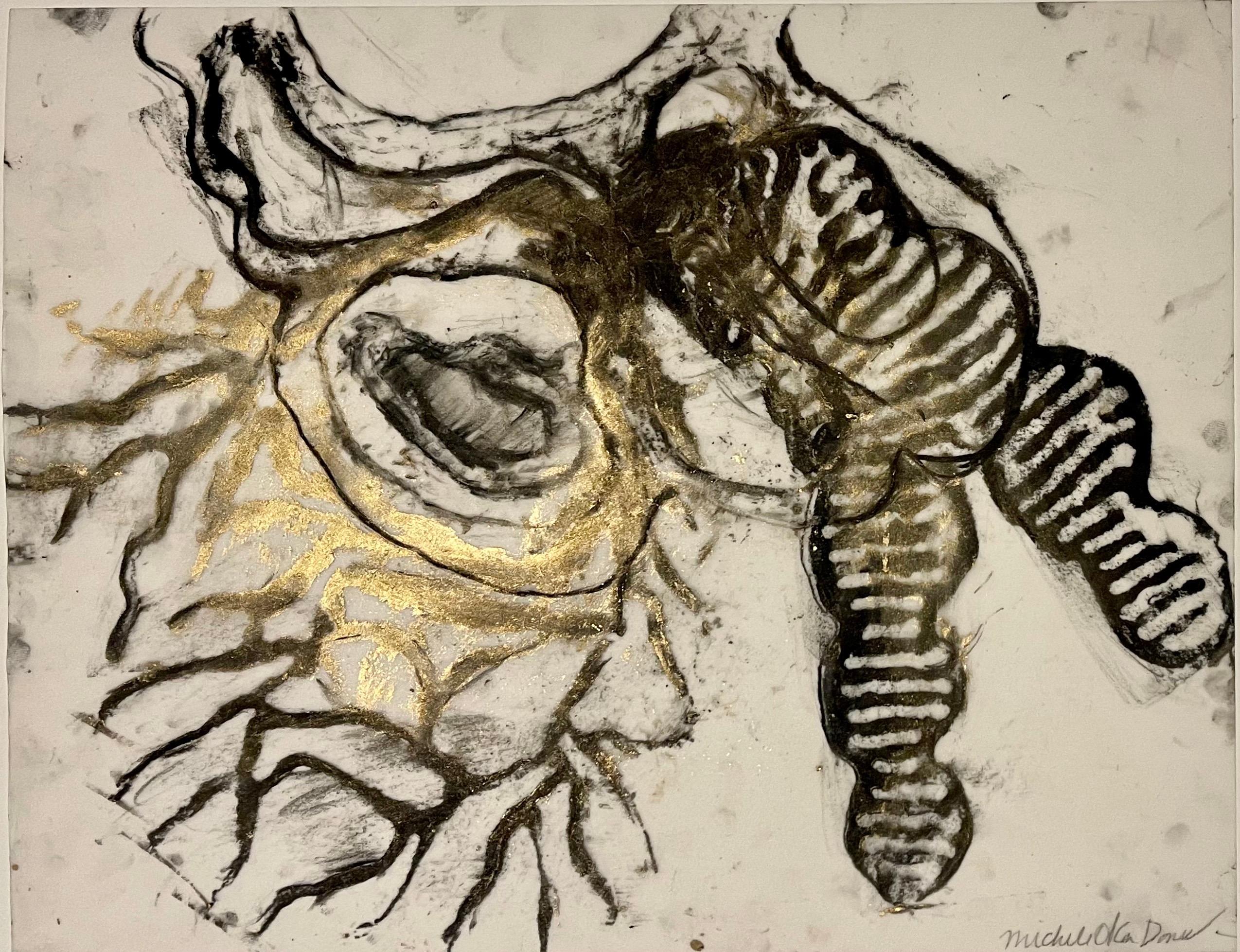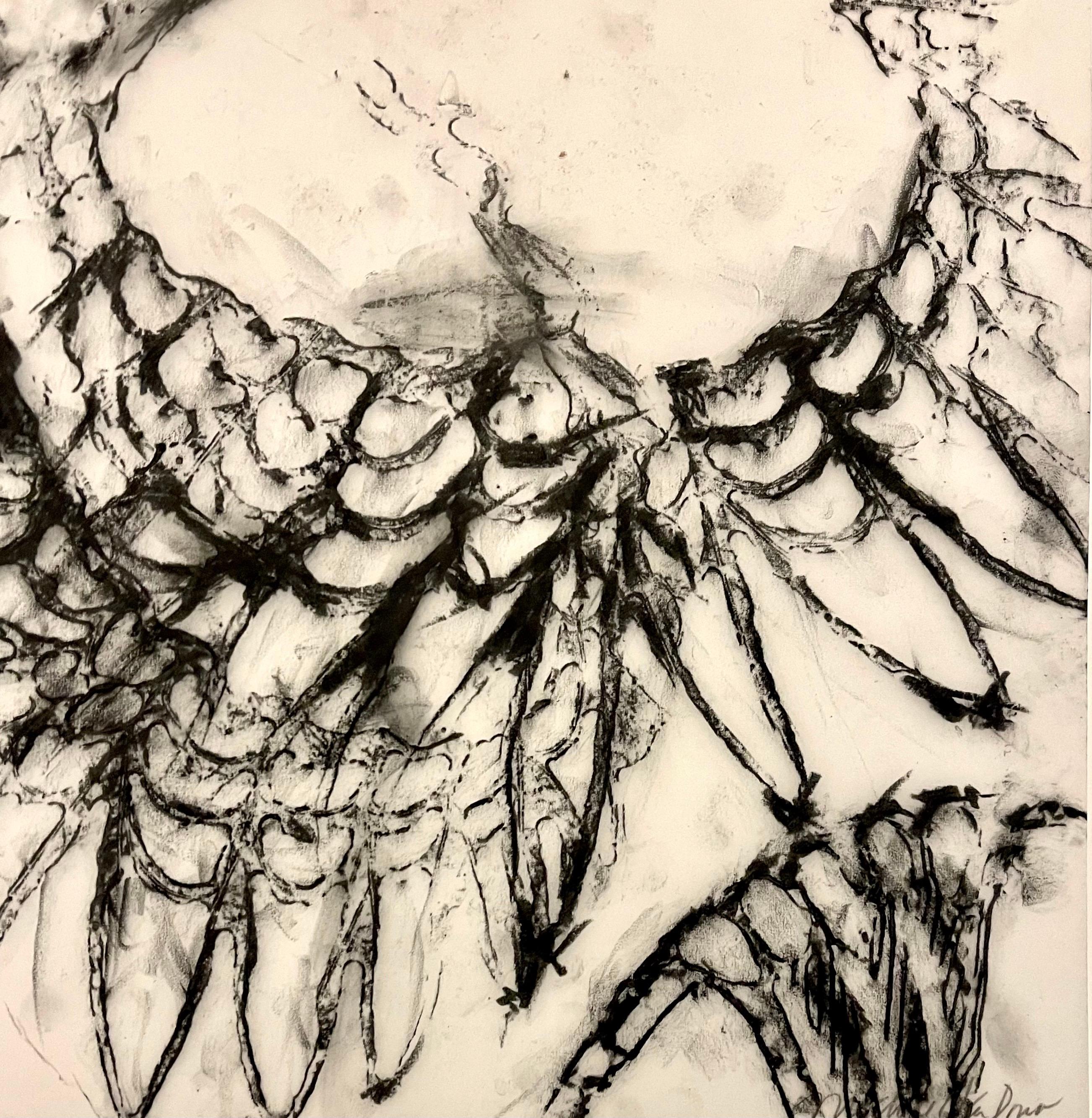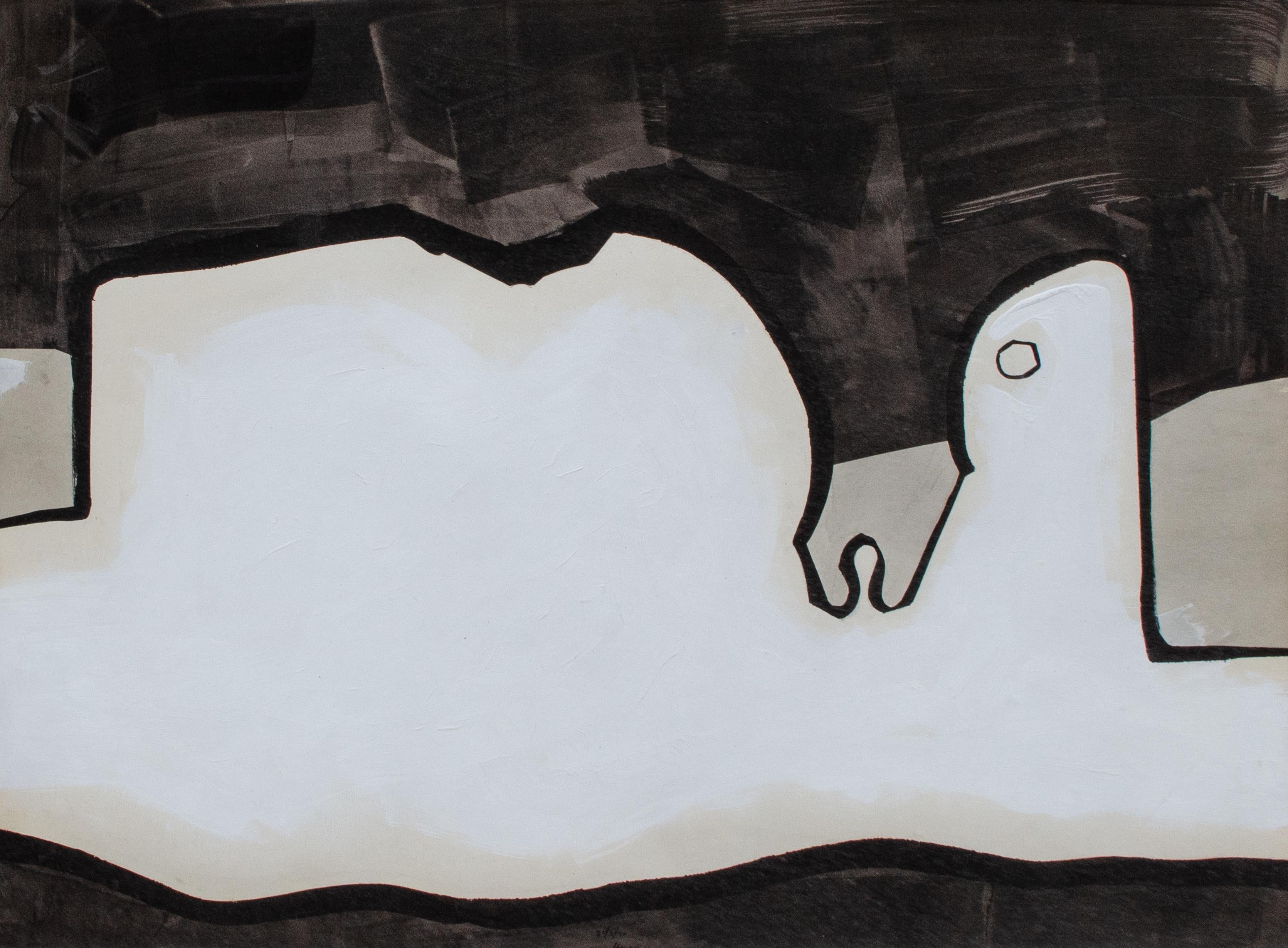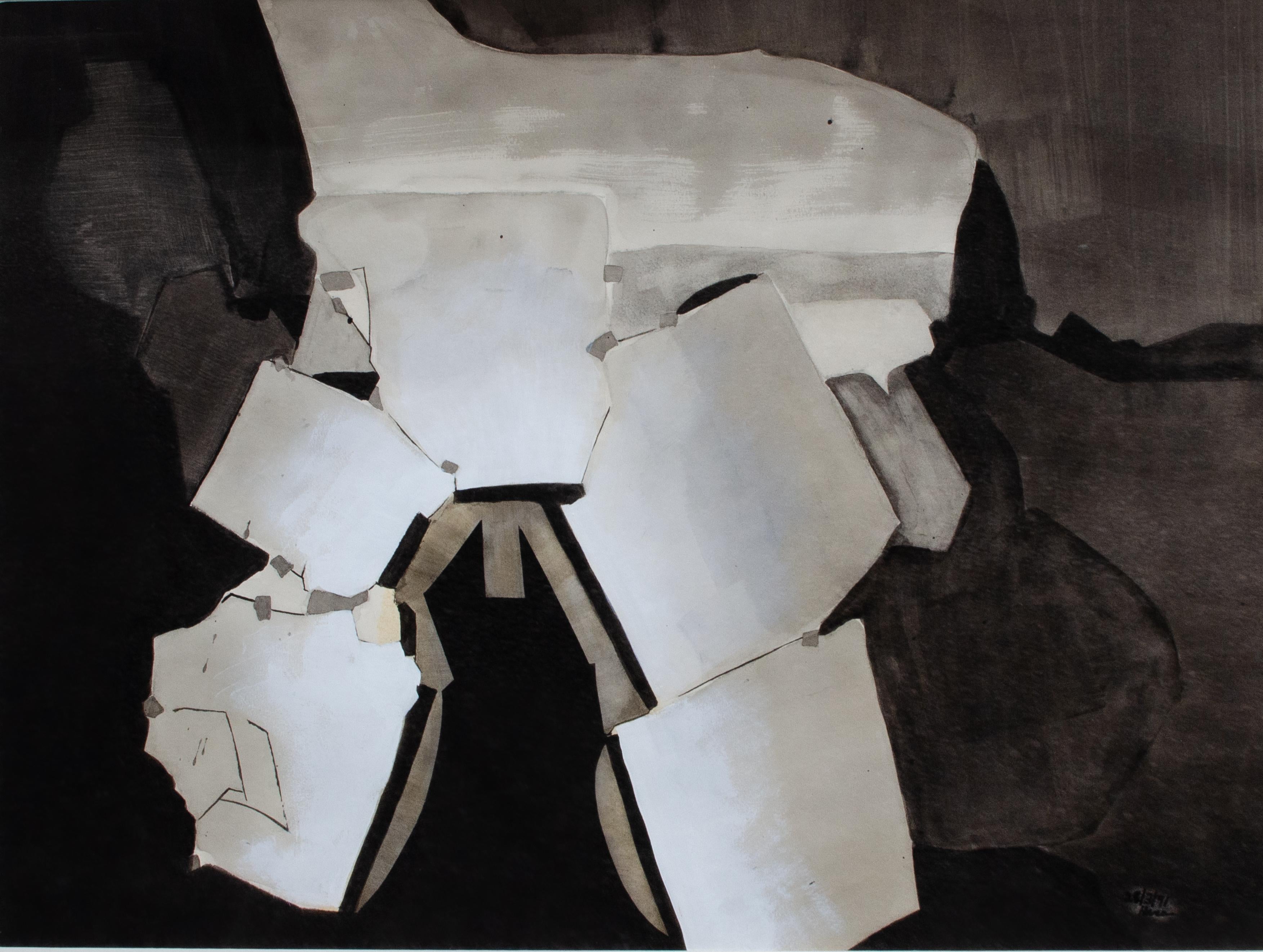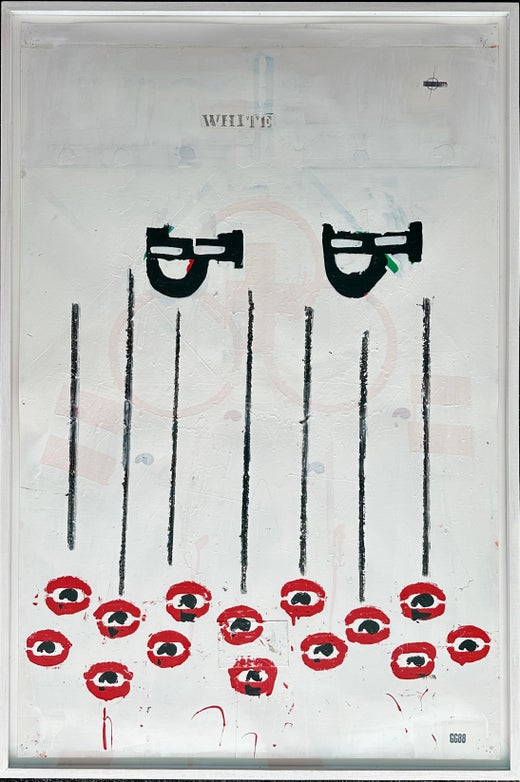Items Similar to O.P. 88 collage on paper by Glenn Goldberg
Video Loading
Want more images or videos?
Request additional images or videos from the seller
1 of 14
Glenn GoldbergO.P. 88 collage on paper by Glenn Goldberg1988
1988
About the Item
O.P. 88 (1988)
Pencil, ink, enamel and collage on paper
46" x 30"
48 ½" x 32 ½" x 2" framed
Stamped "GG88" lower right by artist with his signature stamp.
Provenance: M. Knoedler & Company, New York, NY (label verso)
Barbara Krakow Gallery, Boston MA (label verso)
About the artist: Goldberg often utilizes a grisaille palette to create eclectic pieces with intricate detail. Mistakes and flaws play a key role in the artist’s work. He is inspired by tapestries, ancient calligraphy, and decorative rugs. His work lacks a narrative context to hopefully enable the viewer to discover the themes he chose to include.
Goldberg is an artist and musician. He attended James Monroe High School and received his MFA from Queens College CUNY. His work is included in numerous museum collections, such as the Brooklyn Museum of Art, NY and the Metropolitan Museum of Art, NY. Goldberg is a Guggenheim Fellow and a Professor at The Cooper Union and Queens College CUNY.
– from the Vermont Studio Center
- Creator:Glenn Goldberg (1953, American)
- Creation Year:1988
- Dimensions:Height: 46 in (116.84 cm)Width: 30 in (76.2 cm)
- Medium:
- Movement & Style:
- Period:
- Condition:
- Gallery Location:Hudson, NY
- Reference Number:
Glenn Goldberg
Glenn Goldberg is an artist and musician, born in The Bronx 1953, working in Brooklyn, and living in Manhattan.
About the Seller
5.0
Vetted Seller
These experienced sellers undergo a comprehensive evaluation by our team of in-house experts.
Established in 1973
1stDibs seller since 2023
6 sales on 1stDibs
Typical response time: 1 hour
- ShippingRetrieving quote...Ships From: Hudson, NY
- Return PolicyThis item cannot be returned.
More From This SellerView All
- Untitled-019 gouache and pencil by Vaclav VytlacilBy Vaclav VytlacilLocated in Hudson, NYDelightful petite abstract work by American abstract artist Vaclav Vytlacil. About this artist: Born in 1892 to Czechoslovakian parents in New York, Vaclav Vytlacil and his parents ...Category
1930s Abstract Expressionist Abstract Drawings and Watercolors
MaterialsPaper, Gouache, Cardboard, Pencil
- Untitled mixed media painting by Hans BurkhardtBy Hans BurkhardtLocated in Hudson, NYFrom December 30, 1979, a small mixed media piece by the Swiss/American artist Hans Burkhardt. Gifted from the artist to his daughter, by descent to her son, this work is now availab...Category
1970s Abstract Mixed Media
MaterialsPaper, Ink, Watercolor
- Untitled-005 mixed media on paper by John Von WichtBy John von WichtLocated in Hudson, NYThis abstract artwork is one of a group of over 100 pieces personally selected by the artist, and gifted to a close personal friend in 1969. Please note this painting was never matte...Category
1950s Abstract Expressionist Abstract Drawings and Watercolors
MaterialsPaper, Mixed Media
- Untitled-059 mixed media on paper by John Von WichtBy John von WichtLocated in Hudson, NYThis abstract artwork is one of a group of over 100 pieces personally selected by the artist, and gifted to a close personal friend in 1969. Please note that this painting was never ...Category
1960s Abstract Expressionist Abstract Drawings and Watercolors
MaterialsPaper, Mixed Media
- Untitled-052 mixed media on paper by John Von WichtBy John von WichtLocated in Hudson, NYThis abstract artwork is one of a group of over 100 pieces personally selected by the artist, and gifted to a close personal friend in 1969. Please note that this painting was never ...Category
1960s Abstract Expressionist Abstract Drawings and Watercolors
MaterialsPaper, Mixed Media
- Untitled mixed media and collage artwork by Fred MartinBy Fred MartinLocated in Hudson, NYFantastic mixed media collage, created by Fred Martin as a thank you to gallery owners for their interest and support of his work. Untitled (2014) Mixed m...Category
2010s Abstract Mixed Media
MaterialsPaper, Mixed Media
You May Also Like
- Blood and Light (2021)Located in Jersey City, NJDrawing / Geometric Abstraction / Mythology and Religion / Bright and Vivid Colors / Black and White Enamel, ink, colored pencil and alcohol ink on paper....Category
2010s Abstract Geometric Mixed Media
MaterialsEnamel
- Searching (II), 2021Located in Jersey City, NJDrawing / Geometric Abstraction / Mythology and Religion / Bright and Vivid Colors / Black and White Enamel, ink, colored pencil and alcohol ink on paper....Category
2010s Abstract Geometric Mixed Media
MaterialsEnamel
- Original Drawing Painting Abstract Biomorphic Art Gold Leaf Michele Oka DonerBy Michele Oka DonerLocated in Surfside, FLThis is mixed media. I am not positive of the materials. it is a translucent, vellum, parchment type of paper. with either charcoal or ink and gold leaf (or gold paint) hand signed in pencil lower right. It is not titled on it. Michele Oka Doner (born 1945, Miami Beach, Florida, United States) is an American artist and author who works in a variety of media including sculpture, lithograph and woodcut prints, drawing, watercolor painting, functional objects and video. Her workes is based on flora, fauna, DNA and all sorts of exotica. She has also worked in costume and set design and has created over 40 public and private permanent art installations, including her best known artwork is "A Walk on the Beach" (1995, 1999), and its extension, "A Walk on the Beach: Tropical Gardens" (1996–2010) at the Miami International Airport. It is composed of over 9000 bronzes embedded in terrazzo with mother-of-pearl. At one and quarter linear miles, it is one of the largest artworks in the world. Born and raised in Miami Beach, Oka Doner is the granddaughter of painter Samuel Heller. Oka Doner's father, Kenneth Oka, was elected judge and mayor of Miami Beach during her youth (1945–1964). The family lived a public and politically active life. In later years, Oka Doner co-authored, with Mitchell Wolfson Jr. Miami Beach: Blueprint of an Eden, an intimate portrayal of Miami Beach from the 1920s to the 1960s using their families as prisms to reflect the times. Reviewed as classic of social history, with material that was part of the public record of its time, it was used as a textbook in Human Geography at George Washington University in 2008. In 1957, age 12, Oka Doner began a year-long independent project studying the International Geophysical Year (IGY). She assembled a book of drawings, writings and collages that became a template for projects realized in later years. In 1963, Oka Doner left Florida for the University of Michigan, Ann Arbor. Her art instructor Milton Cohen was experimenting with The Space Theater and George Manupelli began the Ann Arbor Film Festival. Their students were engaged in poetry, dance, light, music, all combined into a unitary vision, a motif that shaped Oka Doner's student years and is characteristic of her work today. Oka Doner participated in a Manupelli experimental film, a "Map Read" performance with art drawing instructor Al Loving and Judsonite dancer Steve Paxton as well as several "Happenings." Another influence was art historian and Islamic scholar, Oleg Grabar, who illustrated how patterns in architecture are able to dissolve space. A Death Mask, one of her first works, was selected as the cover of Generation, the University's avant garde journal, as campus unrest over the Vietnam war escalated. Her Tattooed Porcelain Dolls were adopted by students protesting the U.S.'s use of napalm... their heads (when they have them) with eyes closed, moth half-open and brain visible, fall into the category of surrealistic objects, but with a surrealism filled with a sap which is naive, barbaric and young." Oka Doner received a Bachelor of Science and Design from the University of Michigan (1966), a M.F.A. (1968), was Alumna-in-Residence (1990), received the Distinguished Alumna Award from the School of Art (1994) and was a Penny Stamps Distinguished Speaker (2008). She was awarded the honorary degree, Doctor of Arts (2016). Upon graduation in 1968, Oka Doner established a studio in downtown Ann Arbor behind the art gallery "Editions, Inc.," where physicist Lloyd Cross and sculptor Jerry Pethick were experimenting with holography. Using a krypton laser, they created the first art holograms. One of Oka Doner's sculptures was appropriated for this experiment. The "Ceramic Doll" opened in the world's first exhibition of holograms at the Cranbrook Academy Art in 1970. Oka Doner moved to Detroit and exhibited at the Gertrude Kasle Gallery in 1971. In 1975, a new body of work, Burial Pieces was laid out on the floor of Gallery 7, then a Cooperative Gallery of black artists, led by Charles McGee. It was the first of many installations that shed pedestals and traditional ways of displaying sculpture. A one-person show at the Detroit Institute of Arts followed in 1977. Works in Progress, also forsook conventional props. Oka Doner installed on the floor of the North Court thousands of pieces of clay depicting images of writing and seeds in the process of germinating. In 1979, the DIA initiated a small group exhibition, "Image and Object in Contemporary Sculpture," including Michele Oka Doner, Scott Burton, Dennis Oppenheim, and Terry Allen, which traveled to P.S. 1, New York. In 1981, Oka Doner moved to New York City and embarked on a series of public art installations. In 1987, she won a national competition sponsored by the MTA's Arts For Transit Program with Radiant Site a 165 ft. long wall for the Herald Square subway station in New York City. The late architect Morris Lapidus said of "Celestial Plaza," "By laying these forms at our feet, she encourages us to stop and search the sparkling expanse for landmarks just as we would search the night sky." In 2009–2010, Oka Doner installed SoulCatchers, approximately 400 shamanistic sculptures in the kiln room at the Nymphenburg Porcelain Manufactury, Munich, Germany.). Solo exhibitions of her work have been held at the Detroit Institute of Arts, Michigan; Germans Van Eck, Diane Brown...Category
Early 2000s Abstract Abstract Drawings and Watercolors
MaterialsGold Leaf
- Original Drawing Painting Abstract Biomorphic Art Phoenix Bird Michele Oka DonerBy Michele Oka DonerLocated in Surfside, FLThis is mixed media. I am not positive of the materials. it is a translucent, vellum, parchment type of paper. with either charcoal or ink, hand signed in pencil lower right. It is not titled on it. Michele Oka Doner...Category
Early 2000s Abstract Abstract Drawings and Watercolors
MaterialsGold Leaf
- "Cronus Asleep in the Cave" Mixed Media Work on Paper by David HareBy David HareLocated in New York, NYDavid Hare Cronus Asleep in the Cave, 1971 Acrylic, ink wash, graphite, paper collage on paper on board 26 x 35 inches “Freedom is what we want,” David Hare boldly stated in 1965, b...Category
1970s Abstract Abstract Paintings
MaterialsAcrylic, Paper, Ink, Graphite
- "Cronus View from the Cave" Abstract Mixed Media Composition by David HareBy David HareLocated in New York, NYDavid Hare Cronus View from the Cave, 1971 Graphite, Ink wash, Paper Collage on Paper on Board 25 x 33 inches “Freedom is what we want,” David Hare boldly stated in 1965, but then he added the caveat, “and what we are most afraid of.” No one could accuse David Hare of possessing such fear. Blithely unconcerned with the critics’ judgments, Hare flitted through most of the major art developments of the mid-twentieth century in the United States. He changed mediums several times; just when his fame as a sculptor had reached its apogee about 1960, he switched over to painting. Yet he remained attached to surrealism long after it had fallen out of official favor. “I can’t change what I do in order to fit what would make me popular,” he said. “Not because of moral reasons, but just because I can’t do it; I’m not interested in it.” Hare was born in New York City in 1917; his family was both wealthy and familiar with the world of modern art. Meredith (1870-1932), his father, was a prominent corporate attorney. His mother, Elizabeth Sage Goodwin (1878-1948) was an art collector, a financial backer of the 1913 Armory Show, and a friend of artists such as Constantin Brancusi, Walt Kuhn, and Marcel Duchamp. In the 1920s, the entire family moved to Santa Fe, New Mexico and later to Colorado Springs, in the hope that the change in altitude and climate would help to heal Meredith’s tuberculosis. In Colorado Springs, Elizabeth founded the Fountain Valley School where David attended high school after his father died in 1932. In the western United States, Hare developed a fascination for kachina dolls and other aspects of Native American culture that would become a recurring source of inspiration in his career. After high school, Hare briefly attended Bard College (1936-37) in Annandale-on-Hudson. At a loss as to what to do next, he parlayed his mother’s contacts into opening a commercial photography studio and began dabbling in color photography, still a rarity at the time [Kodachrome was introduced in 1935]. At age 22, Hare had his first solo exhibition at Walker Gallery in New York City; his 30 color photographs included one of President Franklin Roosevelt. As a photographer, Hare experimented with an automatist technique called “heatage” (or “melted negatives”) in which he heated the negative in order to distort the image. Hare described them as “antagonisms of matter.” The final products were usually abstractions tending towards surrealism and similar to processes used by Man Ray, Raoul Ubac, and Wolfgang Paalen. In 1940, Hare moved to Roxbury, CT, where he fraternized with neighboring artists such as Alexander Calder and Arshile Gorky, as well as Yves Tanguy who was married to Hare’s cousin Kay Sage, and the art dealer Julian Levy. The same year, Hare received a commission from the American Museum of Natural History to document the Pueblo Indians. He traveled to Santa Fe and, for several months, he took portrait photographs of members of the Hopi, Navajo, and Zuni tribes that were published in book form in 1941. World War II turned Hare’s life upside down. He became a conduit in the exchange of artistic and intellectual ideas between U.S. artists and the surrealist émigrés fleeing Europe. In 1942, Hare befriended Andre Breton, the principal theorist of surrealism. When Breton wanted to publish a magazine to promote the movement in the United States, he could not serve as an editor because he was a foreign national. Instead, Breton selected Hare to edit the journal, entitled VVV [shorth for “Victory, Victory, Victory”], which ran for four issues (the second and third issues were printed as a single volume) from June 1942 to February 1944. Each edition of VVV focused on “poetry, plastic arts, anthropology, sociology, (and) psychology,” and was extensively illustrated by surrealist artists including Giorgio de Chirico, Roberto Matta, and Yves Tanguy; Max Ernst and Marcel Duchamp served as editorial advisors. At the suggestion of Jacqueline Lamba...Category
1970s Abstract Abstract Paintings
MaterialsPaper, Ink, Graphite
